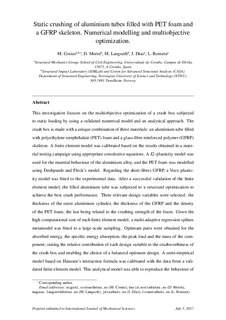| dc.contributor.author | Costas, Miguel | |
| dc.contributor.author | Morin, David | |
| dc.contributor.author | Langseth, Magnus | |
| dc.contributor.author | Díaz, Jacobo M. | |
| dc.contributor.author | Romera, Luis Esteban | |
| dc.date.accessioned | 2017-07-06T12:12:29Z | |
| dc.date.available | 2017-07-06T12:12:29Z | |
| dc.date.created | 2017-07-05T09:56:23Z | |
| dc.date.issued | 2017 | |
| dc.identifier.issn | 0020-7403 | |
| dc.identifier.uri | http://hdl.handle.net/11250/2448074 | |
| dc.description.abstract | This investigation focuses on the multiobjective optimization of a crash box subjected to static loading by using a validated numerical model and an analytical approach. The crash box is made with a unique combination of three materials: an aluminium tube filled with polyethylene terephthalate (PET) foam and a glass-fibre reinforced polymer (GFRP) skeleton. A finite element model was calibrated based on the results obtained in a material testing campaign using appropriate constitutive equations. A J2–plasticity model was used for the material behaviour of the aluminium alloy, and the PET foam was modelled using Deshpande and Fleck’s model. Regarding the short-fibres GFRP, a Voce plasticity model was fitted to the experimental data. After a successful validation of the finite element model, the filled aluminium tube was subjected to a structural optimization to achieve the best crash performance. Three relevant design variables were selected: the thickness of the outer aluminium cylinder, the thickness of the GFRP and the density of the PET foam, the last being related to the crushing strength of the foam. Given the high computational cost of each finite element model, a multi-adaptive regression splines metamodel was fitted to a large-scale sampling. Optimum pairs were obtained for the absorbed energy, the specific energy absorption, the peak load and the mass of the component; stating the relative contribution of each design variable to the crashworthiness of the crash box and enabling the choice of a balanced optimum design. A semi-empirical model based on Hanssen’s interaction formula was calibrated with the data from a validated finite element model. This analytical model was able to reproduce the behaviour of the component over the design region selected for the optimization, and was also used for its optimization with satisfactory results. | nb_NO |
| dc.language.iso | eng | nb_NO |
| dc.publisher | Elsevier | nb_NO |
| dc.title | Static crushing of aluminium tubes filled with PET foam and a GFRP skeleton. Numerical modelling and multiobjective optimization. | nb_NO |
| dc.type | Journal article | nb_NO |
| dc.type | Peer reviewed | nb_NO |
| dc.description.version | submittedVersion | nb_NO |
| dc.source.journal | International Journal of Mechanical Sciences | nb_NO |
| dc.identifier.doi | https://doi.org/10.1016/j.ijmecsci.2017.07.004 | |
| dc.identifier.cristin | 1480900 | |
| dc.description.localcode | This is the authors' manuscript to the article (preprint). | nb_NO |
| cristin.unitcode | 194,64,45,0 | |
| cristin.unitname | Institutt for konstruksjonsteknikk | |
| cristin.ispublished | false | |
| cristin.fulltext | preprint | |
| cristin.qualitycode | 1 | |
